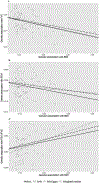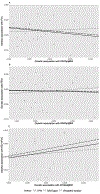The impact of obesity on lung function measurements and respiratory disease: A Mendelian randomization study
- PMID: 37009668
- PMCID: PMC10293090
- DOI: 10.1111/ahg.12506
The impact of obesity on lung function measurements and respiratory disease: A Mendelian randomization study
Abstract
Introduction: Observational studies have shown that body mass index (BMI) and waist-to-hip ratio (WHR) are both inversely associated with lung function, as assessed by forced vital capacity (FVC) and forced expiratory volume in 1 s (FEV1). However, observational data are susceptible to confounding and reverse causation.
Methods: We selected genetic instruments based on their relevant large-scale genome-wide association studies. Summary statistics of lung function and asthma came from the UK Biobank and SpiroMeta Consortium meta-analysis (n = 400,102). After examining pleiotropy and removing outliers, we applied inverse-variance weighting to estimate the causal association of BMI and BMI-adjusted WHR (WHRadjBMI) with FVC, FEV1, FEV1/FVC, and asthma. Sensitivity analyses were performed using weighted median, MR-Egger, and MRlap methods.
Results: We found that BMI was inversely associated with FVC (effect estimate, -0.167; 95% confidence interval (CI), -0.203 to -0.130) and FEV1 (effect estimate, -0.111; 95%CI, -0.149 to -0.074). Higher BMI was associated with higher FEV1/FVC (effect estimate, 0.079; 95%CI, 0.049 to 0.110) but was not significantly associated with asthma. WHRadjBMI was inversely associated with FVC (effect estimate, -0.132; 95%CI, -0.180 to -0.084) but has no significant association with FEV1. Higher WHR was associated with higher FEV1/FVC (effect estimate, 0.181; 95%CI, 0.130 to 0.232) and with increased risk of asthma (effect estimate, 0.027; 95%CI, 0.001 to 0.053).
Conclusion: We found significant evidence that increased BMI is suggested to be causally related to decreased FVC and FEV1, and increased BMI-adjusted WHR could lead to lower FVC value and higher risk of asthma. Higher BMI and BMI-adjusted WHR were suggested to be causally associated with higher FEV1/FVC.
© 2023 John Wiley & Sons Ltd/University College London.
Conflict of interest statement
Conflict of Interest Statement:
The authors declare that there is no conflict of interests.
Figures



Similar articles
-
Association of Genetic Instrumental Variables for Lung Function on Coronary Artery Disease Risk: A 2-Sample Mendelian Randomization Study.Circ Genom Precis Med. 2018 Apr;11(4):e001952. doi: 10.1161/CIRCGEN.117.001952. Circ Genom Precis Med. 2018. PMID: 29650766
-
Using a Two-Sample Mendelian Randomization Study Based on Genome-Wide Association Studies to Assess and Demonstrate the Causal Effects of Allergic Rhinitis on Chronic Lower Respiratory Diseases and Lung Function.Int Arch Allergy Immunol. 2023;184(4):311-319. doi: 10.1159/000528350. Epub 2023 Jan 11. Int Arch Allergy Immunol. 2023. PMID: 36630930
-
Causal Relationship Between Lung Function and Atrial Fibrillation: A Two Sample Univariable and Multivariable, Bidirectional Mendelian Randomization Study.Front Cardiovasc Med. 2021 Nov 11;8:769198. doi: 10.3389/fcvm.2021.769198. eCollection 2021. Front Cardiovasc Med. 2021. PMID: 34869686 Free PMC article.
-
A large-scale genome-wide association analysis of lung function in the Chinese population identifies novel loci and highlights shared genetic aetiology with obesity.Eur Respir J. 2021 Oct 14;58(4):2100199. doi: 10.1183/13993003.00199-2021. Print 2021 Oct. Eur Respir J. 2021. PMID: 33766948 Free PMC article.
-
Genetic liability of gut microbiota for idiopathic pulmonary fibrosis and lung function: a two-sample Mendelian randomization study.Front Cell Infect Microbiol. 2024 May 22;14:1348685. doi: 10.3389/fcimb.2024.1348685. eCollection 2024. Front Cell Infect Microbiol. 2024. PMID: 38841114 Free PMC article.
Cited by
-
Effects of High-Intensity Intermittent Training Combined with Asparagus officinalis Extract Supplementation on Cardiovascular and Pulmonary Function Parameters in Obese and Overweight Individuals: A Randomized Control Trial.J Funct Morphol Kinesiol. 2025 Jun 1;10(2):202. doi: 10.3390/jfmk10020202. J Funct Morphol Kinesiol. 2025. PMID: 40566452 Free PMC article.
-
Association between clinical and pulmonary function features and diagnosis of cough variant asthma: a case-control study.BMJ Open. 2025 Feb 22;15(2):e084721. doi: 10.1136/bmjopen-2024-084721. BMJ Open. 2025. PMID: 39987008 Free PMC article.
-
Effect of Elevated Body Mass Index on Outcomes of Transcatheter Aortic Valve Replacement for Severe Aortic Stenosis.Anatol J Cardiol. 2024 Oct 7;28(12):565-74. doi: 10.14744/AnatolJCardiol.2024.4637. Online ahead of print. Anatol J Cardiol. 2024. PMID: 39373331 Free PMC article.
-
Causal effect of life-course adiposity on the risk of respiratory diseases: a Mendelian randomization study.Nutr Metab (Lond). 2025 Mar 21;22(1):25. doi: 10.1186/s12986-025-00915-2. Nutr Metab (Lond). 2025. PMID: 40119483 Free PMC article.
-
Association Between Chronic Obstructive Pulmonary Disease and Low Muscle Mass in Korean Adults.J Clin Med. 2025 Feb 10;14(4):1134. doi: 10.3390/jcm14041134. J Clin Med. 2025. PMID: 40004664 Free PMC article.

